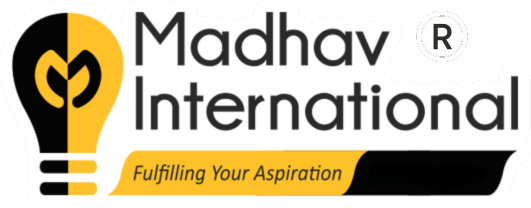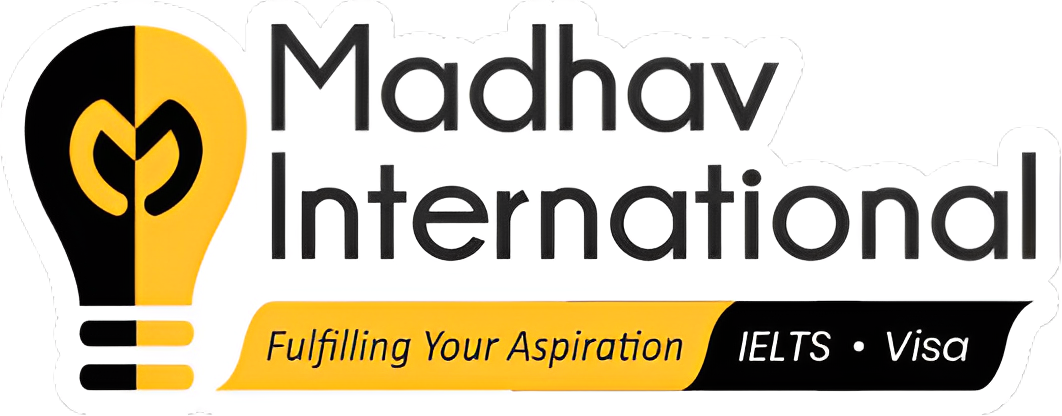Study Abroad
- Study In Canada
- Study In USA
- Study In UK
- Study In Australia
- Study In New Zealand

Any Questions? Call us
+91 97127 89001
Any Questions? Email us
info@madhavinternational.co.in

Why USA ?
The United States of America is the world’s 3rd or 4th largest country by total area. The extremely diverse geography, climate, and wildlife of the United States make it one of the world’s 17 mega diverse countries. One of the most attractive features of the U.S. higher education system is the flexibility it provides through the number and diversity of institution types it encompasses. More than 4,500 accredited institutions make up U.S. higher education in the United States.
California, one of the 50 states of the USA, itself has a GDP that is higher than Brazil or even France for that matter. English, Spanish, German, French are just a few of the languages spoken across the land. A country brought to life by immigrants, the USA is a dream destination of people around the world. Boston, Seattle, Bellevue in Washington, San Jose, Newton in Massachusetts, and Pleasanton in California are just a few of the most sought after cities to live in the country.
For a foreign/international student, the USA has a lot to offer: the most prestigious education in the world, eclectic cities and beautiful parks, artistic, cultural, political, sporting events and a very multi-ethnic population. USA is in demand for studying abroad for international students.
Highlights of USA
Capital: Washington, D.C.
Currency: United States Dollar
Major Cities: New York city, Los Angeles, Chicago, Houston
Language: English
Major Intake: January, August, September, October, November
Population: 22,942,649 |2013 Estimate|
Area: 9,826,675 KM2 – 3,794,101 Mi2
Study in USA
With a variety of options to spend and to choose from, USA has been an amazing place for a student to live in. With globally recognized and flexible educational programs, students can actually get something more than they desire. Apart from the academics, a student can also consider the culture and the style of living of the United States.
Another reason to choose to Study in USA is post studies OPT options. OPT Optional Practical Training (OPT) is a period during which undergraduate and graduate students with F-1 status who have completed or have been pursuing their degrees for more than nine months are permitted by the United States Citizenship and Immigration Services (USCIS) to work for at most one year on a student visa towards getting practical training to complement their field of studies. F-1 students are usually permitted a total of 12 months of practical training. Post the 12 months completion, students from STEM background (Science, Technology, Engineering, or Mathematics degree) may also be eligible to apply for up to 24 months extension on OPT.
USA ranks the top for having around 60 percent of the world’s best universities, giving an individual the best options for future.
- Research and Training Opportunities: U.S. universities offer research and training opportunities to international students at the graduate level.
- Career Opportunities: Due to the varied insight into different fields of study offered by universities of USA, it broadens the scope of the career path that the student chooses.
- Help and support to International students: It is challenging for international students to adhere or get accustomed to the new student life in an international university. However, most US universities provide good guidance and support to all students whether it is related to accommodation, visa status, career opportunities, etc.
Education System
The United States of America provides highly distinct and innovative education systems. It provides them a high quality of learning and research opportunities over and above recruitment support and network building opportunities.
The most important part of the USA Education System is “Credit”. The credits are a unit of study which together specifically make up a course. The number of credits required for the completion of a course, vary depending on the type of the course and the university which offers it.
In general, international students need to achieve 12 credits per semester to continue his/her studies, but can eventually take more.
Working on the basis of 12 credits per semester, three semesters per year and four years per degree, and taking into account exam periods, an undergraduate degree would require the student to gain around 130 credits in total, similarly a graduate program would require roughly between 45-60 credits.
Being the Best Education Consultant for Study in the USA, Madhav International gives the best career counselling and visa consultation that helps students to choose the right and appropriate course in the university or college that suits their budgets. This will help a student to make his career in the right ways and get the best education for getting the best job after studies.
Our team of consultants at Madhav International is trained and well-studied to provide the best Visa and Education consultancy for students who are aspiring to get the most affordable and the best education in the United States of America.
Scholarships
Scholarships in the United States can be categorised into two:
- Those allocated by universities
- Those allocated to various funds and organisations, both public and private
The higher the level of the educational program, the better the chances of receiving a scholarship. This means it’ll be much easier for you to obtain a scholarship for a master program than for an undergraduate degree. If your academic performance has been brilliant, you’ve taken part in plenty of social events or volunteer work, or you’ve excelled in sports, you could be considered for a scholarship.
Each university has its own scholarship fund (usually financed through alumni contributions) with its own set of rules and requirements.
Flexibility
The work load, as said before depends on the total number of credits. These credits play an important role in the flexibility that a student gets during pursuing his/her graduation or post-graduation. There are always two criteria in which the student should fall in order to get the graduation done, GPA (Grade Point Average) and Credits. If a student is unable to make it into either of these categories, he/she won’t be able to complete the graduation or the course they are into.
Flexibility mainly comes into play when a student is perfect on credits but short on GPA, they can then either take a subject ‘out-of-course’ to shoot up their GPA. These subjects have to compulsorily be relevant to the course which is been taken by the student. A student can only make his course flexible if he/she gets an option to cross out the subject which he/she has already studied.
Visa Options
If you think that you want to stay and work in the United States after completing your undergraduate degree, make sure that you know your visa requirements and restrictions. Navigating the American immigration process is often stressful and confusing because there are as many visas as there are letters in the alphabet. The eligibility requirements and legal rulings are constantly changing, which does not make the process any easier.
Here are a few of the most common options applicable to graduates. For a full list of all non-immigrant and immigrant visas, visit VisasToUSA.com where you can view other types of visas that may be applicable to you. You will also be able to have your immigration questions answered for free via email by an immigration attorney.
- Practical Training on an F-1 Visa
- Non-Immigrant H3 Visa (Trainee)
- Non-Immigrant Obtaining a Green Card
- Non-Immigrant H-1B Visa Specialty Occupation
- Non-Immigrant R-1 Visa Religious Worker
- Employment-Based Immigration
- Non-Immigrant E1/E2 Visa
- Non-Immigrant L-1 Visa
Cost of Education for International Students
The Institutes Can Cost Variedly Depending Upon Their Status & Courses
They Offer Public (State supported) & Private (Independent)
- Private Institutes (High Cost) $35,000
- Private Institutes (Low Cost) $18,000
- State Institutes (High Cost) $25,000
- State Institutes (Low Cost) $12,000
The tuition fees differ as per courses that are been taken by a student.
Cost of Living Expenses
The living expenses per annum, including the accommodation and daily expenses are about $8,000 to $10,000 (Cost May Vary).
- Rent $150 to $250 per month
- Groceries $50 to $100 per month
- Phone & Utilities $50 per month
- Sundry $50 to $100 per month
The tuition fees differ as per courses that are been taken by a student.
USA Visa Process

Health Insurance
Healthcare in the US can become a major expense in the case of sickness or medical emergency and it is highly advisable that students purchase medical insurance to cover for the possible burden. Several health insurance plans are available in the US for international students and premiums vary based on the plan selected. A few things to consider while selecting insurance include the coverage, both in terms of the ailments covered and the amount covered for, the deductible and the geographical coverage area, among others. The international students’ centre at a university will usually be able to help guide foreign students on obtaining medical coverage. Several universities also allow students to carry overseas insurance.
After Graduation
Congratulations on your Graduation! Now that you have completed your undergraduate degree program in the USA, you now have many options and avenues that you can go down and each option has its own merits and demerits. Choosing the right option will involve a large amount of research and will come down to personal preference – but hopefully the information in our graduate study guide will help you, and point you in the right direction to choose the next step in your international education adventure.
Job Opportunities
Types of Employment available to F‐1 Students while studying or after studies
1. On-Campus Employment :
You must maintain valid F-1 status
You can work up to 20 hours per week while school is in session
You can work full-time on campus during holidays and vacation periods
2. Off Campus Employment through :
Curricular Practical Training (CPT):
Provides opportunity to gain actual employment experience
“An integral part of an established curriculum”.
Defined as “alternate work/study, internship, cooperative education, or any other type of required internship or practicum which is offered by sponsoring employers through cooperative agreements with the school.”
To be eligible for CPT, student must have completed 9 months in lawful status and currently be in F‐1 status.
CPT can be full time (20 hours week) or part time (20 hours or less per week).
Optional Practical Training (OPT):
Available to students who are lawfully enrolled on a full – time basis &have completed at least 1 full academic year.
Employment must be directly related to the students major
12/29 months of OPT available after each degree level completion.
OPT for F‐1 students can occur under 4 circumstances:
During annual vacation & other times when school is not in session (if the student is eligible, and intends to register for the next term or session);
While school is in session provided OPT does not exceed 20 hours a week;
Full‐time after completion of all course requirements for the degree (excluding thesis or the equivalent).
Full‐time after completion of a program. The first 3 circumstances are referred as “pre‐completion” OPT while the 4th circumstance is called “post‐completion” OPT.
Optional Practical Training (OPT):
Students who are pursuing STEM-certified degrees (Sciences, Technology, Engineering and Mathematics) qualify for an additional 24 months extension for OPT.
FAQs about USA
A major is the student’s main field of specialization. For undergraduate students, majors are broad areas such as Chemical Engineering or Physics or Marine Biology, and must be decided at the end of the second year of undergraduate studies at the latest. For graduate students, majors would further concentrate on the specific field of study and are usually decided at the time of admission application.
The department will usually specify the required courses for each major as well as the total number of credits a student must complete, related to the major, in order to graduate.
With permission of the International Student Office, international students may work on campus up to 20 hours/week their first year and can apply to work off-campus in subsequent years.
A minor is a secondary subject that the student is interested in pursuing along with the major. The number of courses a student is required to take for the minor is usually smaller than the same for the major.
MBA programs typically last one to two years.
In the US, students receive credits or units for a course based on the number of hours of lectures or lab work in a week pertaining to that course. In addition to just attending lectures and labs, the student is also required to put in some hours of homework. The overall work expectation for a course is what drives the number of credits assigned.
A student is required to complete a specific number of credits in order to graduate. The requirements may, more specifically, state the number of credits pertaining to the student’s major and minor.International students are allowed to work up to 20 hours every week when their course is on and 40 hours per week during their vacations. They can expect to earn around 7 to 10 Canadian dollars per hour. During co-op terms students can earn up to 10 to 15 Canadian dollars an hour. This can amount to about 400 to 1000 Canadian dollars every month.
The academic year usually runs from August through May with breaks for holidays.
It is not uncommon that a student switches universities after completing a few semesters of study. In this case, credits earned at the first university may be transferred to the second, i.e. applied towards requirements at the second university. Each university has criteria that specify how credits can be transferred, based on the courses taken, accreditation of the original university and others.
Colleges offer only undergraduate degrees while universities offer graduate degrees as well.
GPA (Grade Point Average) is a measure of academic performance in most US institutions. It usually ranges from 0-4 but may also lie within any other range set by the university.
For each class taken, a student is assigned a grade such as A+, A, A-, B+ all the way to F, based on performance on homework’s, tests and exams. On a 4 point GPA scale, each letter grade is assigned a score between 0 and 4. To calculate GPA, the score for each class is first multiplied by the number of credits/units for the class and these products are then summed for all classes. The GPA is this sum of products divided by the total number of credits/units completed by the student.
Transfer students are those who have completed at least 2 years of their degree or diploma in any country and apply for a transfer to a US based university. The number of years that are waived off under this scheme depend on a number of factors. For starters it will depend on the courses covered in India and the grades for the same. It is rare for a student to get an exact transfer for the credits.
A student should keep in mind that the top ten universities have an acceptance ration of only 1% to 4%. A student should always try and improve their chances of admission. To be on the safer side it is important that the students should also apply to other universities offering good programs. The top ten universities always have incredibly stringent entry requirements. Students should keep in mind that rankings could be world-wide, region based or even subject/course based. It is important that, if a student is searching for a ranked university, they search for a university ranked by the course.
American Universities usually require 16 years of education to gain an admission into an MBA or other graduation programme. Students are advised to complete a master’s degree of at least one year before taking admission in an American university. Some of the top ranked universities may give a student with 15 years of education admission provided they have 2 to 3 years of relevant work experience. Rao Consultants has a comprehensive list of universities and colleges that will enrol a student after 15 years of education directly or with work experience.
Students are only allowed to work 20 hours per week on-campus when the classes are on. They can work full-time during the vacation period.
Research your options and define the best one for yourself. Or you can also contact Planet Education office nearest you. Education experts are there to guide you throughout.
Financial assistance is available more often than not, however, getting the same in the first semester can prove difficult. There is a lot of competition for financial assistance and one needs to have a very good academic and test score to qualify for the same. There are a number of instances where students have been able to secure full financial assistance. At Rao Consultants we will try our level best to help you secure financial assistance based on your academics and test scores.
As soon as you are in the US you are governed by the USCIS rule. This rule mandates that you cannot change the school before completing one semester at the school. Make your choice carefully to begin with in order to avoid problems at a later stage.
A student can take the IELTS exam as well since over 2500 of the top universities have started accepting it as well.
If a student is desirous of applying to universities in the US they need to start preparing for the same from a year in advance. This is very advantageous to students who want to apply for scholarships. The common intake dates are the fall session in August/September and the spring session in January/February.

































